|
|
|

Aloe zebrina is a small maculated aloe. Both surfaces of the
leaves has irregular white spots in rows. A peculiar characteristic (not
a defect!) of this plant is that the the tips of the leaves dry out
naturally in summer and during time of drought forming an attractive
curl, so this should not be a cause for concern in cultivation.
|
|
Description: Aloe zebrina
is a small to med sized maculated/striped aloe that form small groups
from offsets at the base of plants of varying size. It can grow up to up
to 160 cm tall and 200 cm in diameter It looks a bit like many other
striped to spotted aloes particularly to
Aloe
saponaria but with slender more elongated leaves. Due to its
wide distribution it is a very variable species and diffrences exist
between populations.
Rosettes: The main rosette gets up to 40 cm tall and just
as wide.
Stem: Plants are usually stemless or with a short stem up to 30
cm long.
Leaves: 15–25, densely clustered into a rosette, without petiole,
15-35 cm long, 6–7(-10) cm widetoward the base, lance-shaped, fleshy,
upper surface rather flat, dull dark green to powdery-glaucous with
often purplish hues in full sun, that bear large oblong whitish spots
more or less arranged in a series of irregular transverse bands, lower
surface convex, very powdery-glaucous with thick long brownish, ,horny,
deltoid, thorns (6–7 mm long, 10–16 mm Apart) on a lighter green edge.
When drought-stricken, the leaf tips tend to dry back and become
somewhat twisted. In some forms the white blotches become more
zebra-like streaks. The leaf sap is yellowish drying purple.
Flowers: Fairly inconspicuous, bisexual dull red/pink striped.
Inflorescence 0.75–2 m tall with stalk copiously branched above the
middle, the branches terminating in lax racemes 30–40 cm long, bracts
linear-lanceolate, approx 1 cm long. Pedicel 6–7 mm long; perianth
tubular, 3–3.5 cm long, 6-lobed, dull red, much inflated around the
ovary, 3 outer lobes acute, many-veined, 3 inner lobes more obtuse and
wider; stamens 6, included; ovary superior, 6-grooved, 3-celled, style
filiform, stigma headlike.
Blooming season: Mainly from February to May, but also June to
August.
Fruit: The fruit is a many-seeded capsule, dehiscing
loculicidally.
Seeds: ± 7 mm long, broadly winged, dark coloured, punctate.
|
|
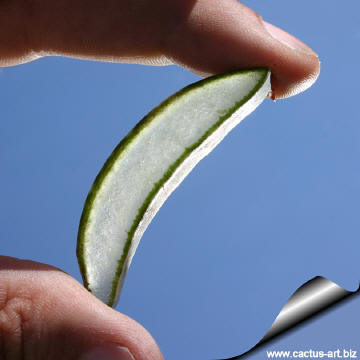
A transversal leaf section (showing the transparent tissues) |
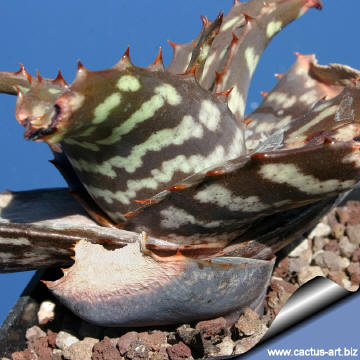
The leaf
margins are armed with prominent dark brown
teeth. |
|
Someone don't regard Aloe
zebrina a good garden subject for its usually dried and twisted leaves
apex and indicate it as a hardly attractive species, while other love
this wild and apparently suffered appearance. |
|
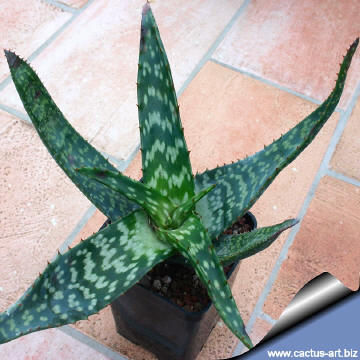
Shadow with ample water availability. |
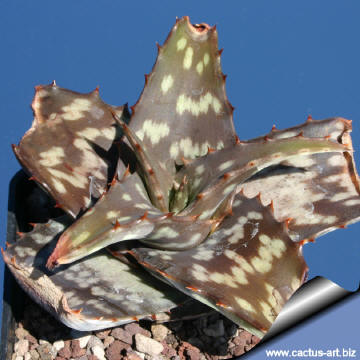
Full sun with withered leaves tips. |
|
|
|
|
Family: Asphodelaceae
Scientific name:
Aloe zebrina Baker
In: Trans. Linn. Soc., ser. 2, Bot. 1: 264 (1878).
Origin: Ranges into Southern Afric,Namibia , Angola,
Botswana, Zimbabwe, Mozambiqu and may be present also in other parts of
tropical Africa.
Habitat: Grow singly or may form extensive
colonies in many different habitats comprising dry thickets, grasslands,
marshy meadows on river banks , open woodlands, rocky outcrops or on
almost bare ground. Altitude range 200–1600 m.
Conservation status: Listed in
CITES appendix 2.
Vernacular names
include: Zebra
Leaf Aloe and Tiger Aloe
Synonyms:
- Aloe transvaalensis var. stenacantsee
- Aloe platyphylla
- Aloe lugardiana
- Aloe bamangwatensis
- Aloe transvaalensis
- Aloe laxissima
- Aloe ammophila
- Aloe angustifolia
|
|
|
|
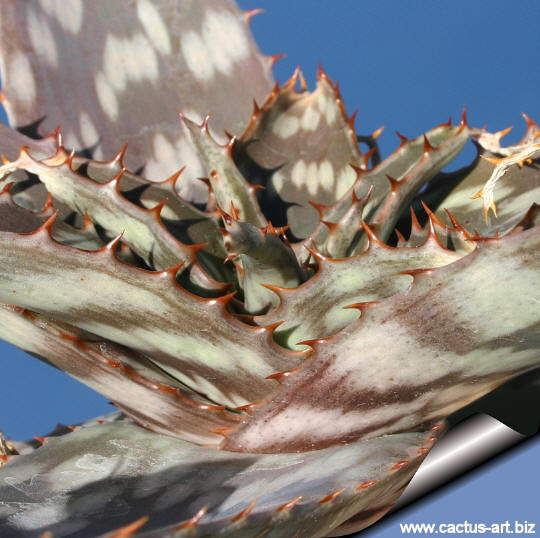
It is very hardy when grown in full sun with the minimum water. When dry
it can stand frost.
Cultivation: Aloe
zebrina is easy to grow and adaptable, it suckers freely and can
form dense groups. It can be grown in large containers. Always use a
good quality, loamy sandy soil with plenty of drainage with chips at the
bottom of containers. It tolerates weekly watering in the summer; once a
month, or not at all in the colder months of December and January. Can
withstand long periods of drought, but they will thrive and flower more
profusely if watered in the correct season. Incorrect watering, poor
drainage or too much shade can lead to attack by pests and diseases.
It need
full sun to
partial shade, but plants grown in partial shade usually look
healthier and more
succulent. It is
however
very hardy when grown in full sun with the minimum
water. This aloe is very
tolerant of
drought, although the tips of the leaves may wither and curl during
hot,
dry periods. Supplemental
watering will help keeping the leaves plump and juicy.
Hardiness: When dry it can stand light frost but it is
damaged in
hard freezes, but recovers quickly. The leaf tips get damaged below
-2°C.
Maintenance: Removal of old flower
stalks; Divide the crowded
clumps periodically. During the
winter months, the plants should be grown cool to initiate flower
development (about 5-10°C ) It grows much better outdoors in spring
and summer.
Propagation: By
division of
offshoots that develop around the outside of the main rosette in
spring, thr cuttings must be dried out for at least 1 week
before planting in river sand. It can also be propagated or by seed
planted in autumn, in trays of coarse river sand. Fresh seeds
germinate quickly at 18°C.
Uses:
- Gardening: In mild climates it can
be cultivated outdoors for use in landscaping, it can be grown in
large, rocky, well-drained soil in gardens in drier areas. Aloe
zebrina adapts well to a variety of soils and climates, but will
grow best in regions with a climate close to that of its native
deserts not too cold, and not too wet.
It makes an excellent ground cover, grows best in a sunny position and
makes a long lasting cut flower.
They grow slowly, but not agonisingly so being able to increase their
witdth by 10- 20 cm per year under favourable conditions.
Photo of conspecific taxa, varieties, forms and
cultivars of plants
belonging to theAloe zebrina complex

 |
|